Our world is standing on edge of a cliff-face, global environmental and social issues are also escalating and reaching a critical no-turning-back from point. It will be the tamariki and rangatahi of today and the future who will have to face these challenges.
But Enviroschools national manager Esther Kirk believes a movement of positive change is also escalating.
“There’s a groundswell of people who are moving from unsustainable, disconnected ways of being, to ones that are healthy, equitable and sustaining for all.” – Esther Kirk, Enviroschools National Manager
Enviroschools aims to empower young people with tools to design and lead their own sustainability projects in their schools and wider communities. Esther says they want to support tamariki and rangatahi to be a part of the solution to a wide range of environmental issues, including climate change.
The groundwork
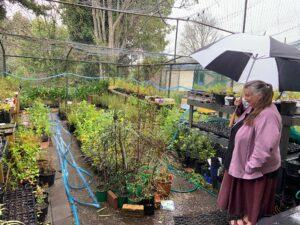
Key teacher, Julie (Maeroa Intermediate), checks out seedlings in the school nursery.
A seed was planted in 1993 in Waikato and by 2001, the Enviroschools Programme became available nationwide. Since then, more than 80 percent of Local Government has invested in Enviroschools, a key milestone achieved since the programme’s inception. Now 120 facilitators work with teachers and communities to support holistic learning and action for a sustainable future.
Enviroschools is guided and supported by Toimata Foundation. Toimata, working in partnership with Te Mauri Tau also holds Te Aho Tū Roa, a kaupapa Māori programme that works with kōhanga/puna reo, kura, wharekura, marae and hapori/communities.
Central Government funding through the Ministry for the Environment, and a large network of more 150 regional partners, enables the reach of Enviroschools and Te Aho Tū Roa.
Toimata Foundation chief executive Heidi Mardon said there are numerous individuals and organisations actively working to help make a more sustainable world.
“The challenge for us is to harness the awareness, experiences, development and energy that has built in our networks over the last 20 years and maximise it for the coming decades.” – Heidi Mardon, CE Toimata Foundation
Esther believes the mahi undertaken by the networks helps to address the root causes of climate change and other environmental issues facing us today.
“We focus on positive solutions and approaches that connect people to te taiao and encourage action.” – Esther Kirk, Enviroschools National Manager
Community action
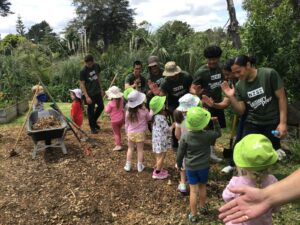
Building friendships and a sustainable community.
Early childhood centres and schools work towards long-term sustainability within their community. Students learn further skills, which they are encouraged to take out and put into practice in their own neighbourhoods and homes.
There are currently (August 2024) more than 1,600 Enviroschools across the country, made up of 500 early childhood centres, 800 primary and intermediate schools and around 200 secondary and composite schools.
In percentage terms, 43 percent of all primary and intermediate schools in New Zealand are involved and 33 percent of all secondary schools.
The kaupapa is about creating a healthy, peaceful, sustainable world through learning and taking action together. It’s all about a community working towards the creation of a resilient, healthy future for everyone.
“In the last two decades both Te Aho Tū Roa and Enviroschools have gone from small-scale initiatives into a nationwide network involving hundreds of thousands of people of all ages. Each year the network undertakes thousands of projects covering all aspects of sustainability and we mihi to our regional coordinators and facilitators, poutautoko, kaiako and teaching teams who are working hard to effect change”. – Esther Kirk, Enviroschools National Manager
Enviroschools and Te Aho Tū Roa provide frameworks for learning and action founded in the idea of a whole school and community approach, with each participant’s journey being unique. Heidi says when students feel empowered, they also feel more motivated and capable to participate in other sustainable practices in their homes and wider community.
Inclusive and holistic
The frameworks do not discriminate against your age, your ethnicity, your language and the way you learn. Diversity is nurtured and even more so, it’s encouraged.
“This is one of the exciting things about the kaupapa – people bringing together their diverse perspectives to create collaborative solutions. We see kaumātau, pakeke, kaiako, rangatahi and tamariki around the country with different ideas, passions and visions for the future. The challenges in each region and whaitua present opportunities for creativity and different solutions. Diversity is what creates richness, and resilience,” says Esther.
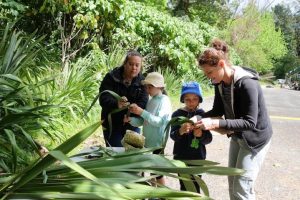
Everyone is encouraged to reflect on learning and action that has taken place over time, celebrate strengths, be honest about realities and explore next steps.
Esther believes children and young people have unique perspectives which should be listened to and considered as real solutions. The programmes are holistic and long-term. Esther explains that encouraging sustainable practices involves addressing interconnected issues. The holistic and systemic approach of Toimata is helping learners to look at root causes and root solutions.
They are also heart-centred and nurture the creation of strong connections. This is a network committed to making large-scale and enduring change. A strong connection to te taiao lies at the heart of learning for all ages taking part in Enviroschools. Toimata works to encourage a culture of care and manaaki, meaning people feel supported while they grow through the programme.
“Empowerment of young people and communities is one key to integrating actions and practices into everyday life. The complex environmental, social, cultural and economic challenges facing us today call for a collaborative response. We mihi to the hundreds of schools and centres, and our partners that have woven their contributions over 20 years, into the vibrant and resilient support model we now have.” – Esther Kirk, Enviroschools National Manager
Mātauranga Māori
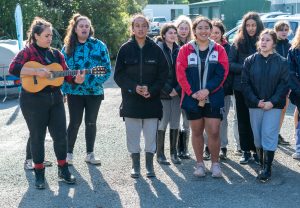
Ākonga from Wellington East Girls College value the opportunity to connect with te ao Māori through their studies.
Enviroschools works to develop sustainable concepts embracing New Zealand’s sense of place and its unique heritage, and Esther says participants are encouraged to explore local Māori knowledge.
Wellington East Girls College teacher Katherine Haines challenged her students in 2020 to think holistically about the ecological design of buildings, incorporating mātauranga Māori and ideas such as kaitiakitanga and manaakitanga. They demonstrated their knowledge through designing a community centre.
The school has further designed a Year 11 science course which focuses on Māori and Pasifika knowledge, and links physics, chemistry, biology and earth sciences to navigation, volcanic studies and climate change.
“Since its inception, Enviroschools has emphasised the importance of understanding that Māori perspectives and knowledge of the environment offer insights unique to the culture with the longest history of human interaction with this country. Including a Māori world view enriches the learning process and honours the indigenous people of this land.” – Heidi Mardon, CE Toimata Foundation
Support for Māori-immersion
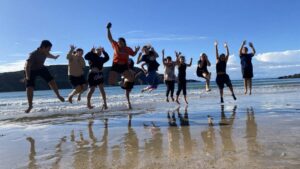
Tūhura Papatūānuku Wānanga at Maitai Bay, Karikari
Te Aho Tū Roa offers kaiako quality resources, events, project opportunities, professional development and kanohi ki te kanohi support for Māori-immersion environments. It aims to engage a creative, intergenerational network inspired and supported to connect: “People to People, People to Place” by weaving current actions with ancestral knowledge and practices.
Around 200 Māori collaborators are linked to the network, with Te Aho Tū Roa engaging with kōhanga and kura and also working with people in hapori (community) settings, on marae, and with iwi.
Noho Taiao events, held in collaboration with iwi are a feature of the approach to reconnecting rangatahi with the taiao. These multi-day experiences weave together science and mātauranga Māori as young people with a whakapapa connection to an area explore its special places and hear kōrero o nehe (local traditional stories).
“We have been humbled by the teachings and oral traditions that have been maintained and transmitted through the generations.” – Participant, Te Aho Tū Roa
Being an Enviroschool
Being an Enviroschool is a journey. Any journey towards sustainability involves a series of small steps that all add up to important changes. Enviroschools recommend first connecting to the history of your place, exploring the current situation, then creating a vision.
“A vision can then lead to taking action on issues that are locally relevant, and ones that students are passionate about. Reflecting on any action is important – be open to learn from things that don’t quite go to plan and always celebrate the process,” says Esther.
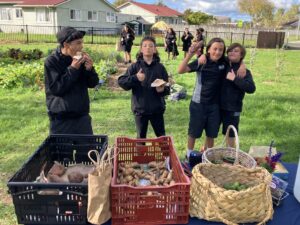
Celebrating the first harvest at the Gudex community garden in Kirikiriroa Hamilton.
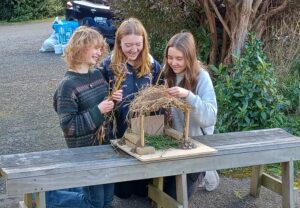
Co-design and creativity.
You can see a range of examples of the action projects that Enviroschools undertake through Our Stories and News and Events articles.
The material above was prepared to contribute to a 2022 Education Gazette article.